Churches of the void-grinder
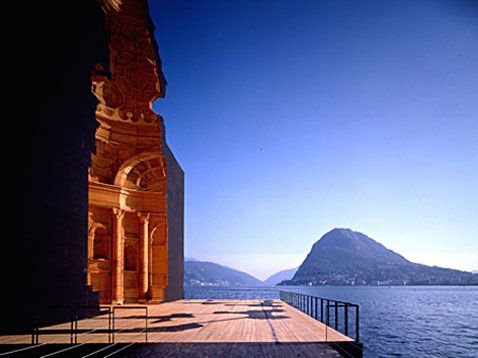 In 1999, Swiss architect Mario Botta was commissioned to design a model of Francesco Borromini’s Church of San Carlo alle Quattro Fontane, in Rome.
In 1999, Swiss architect Mario Botta was commissioned to design a model of Francesco Borromini’s Church of San Carlo alle Quattro Fontane, in Rome. Called San Carlino, Botta's model – part building, part sculpture – was erected near Borromini's own birthplace, on the shores of Lake Lugano, to celebrate the 400th anniversary of Borromini's birth.
The work was dismantled in 2003.
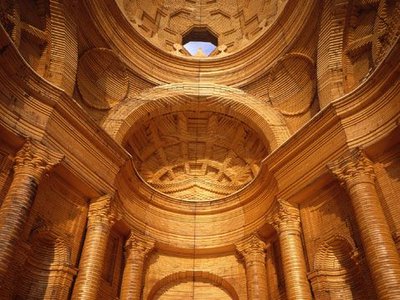
The project was made using 35,000 wood boards, each of which was cut, milled, and sanded, then assembled with the rest to reproduce the exact internal volume of Borromini's church.
Well, half of Borromini's church.

The interior, in other words, was carved out of this colossus of wood; the space of the church was milled, excavated from the stacked material.
This virtual walk-through gives a nice, if badly lit, sense of the abrupt edge Botta designed for the model –
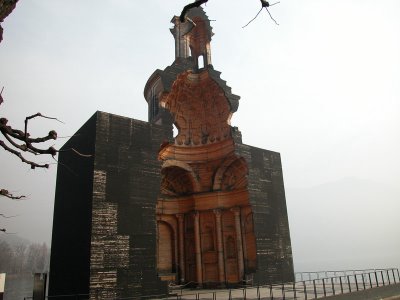
– because as you can see from Botta's own sketch, below, he effectively cut the church in half; measured the internal volume down to the scale of centimeters; then reproduced that void using 35,000 specially cut boards.
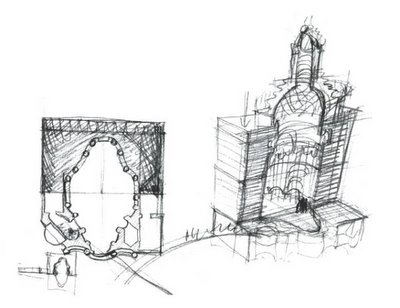
Certain photographs I've seen are actually quite astonishing; the freshly cut boards in the earliest photographs all but glow compared to the coal-black exterior, and the blue skies of Lugano add a surreal backdrop to the unexpected sight of the semi-sacred hollow.
I have to admit, however, that when I first saw those photographs I did not understand what I was looking at. My first reaction was fairly predictable, I suppose, and that was to picture a huge milling-machine, built to the exact volume and measurements of Borromini's church – a kind of void-grinder several stories high, whirring with precise blades and abraders, like some massive (perhaps consecrated) mining machine.
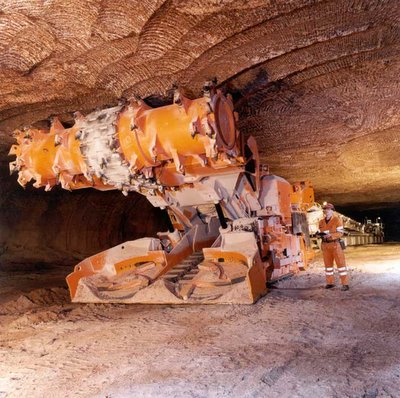
That would, of course, be ridiculous; but it got me thinking.
I wondered if you could precisely measure the interior space of Notre-Dame, for instance, then build or program an industrial-scale grinding machine to those exact specifications. A kind of inside-out abrader. A void-grinder. You could then park that thing in front of a mountain and lo! Three hours later the exact internal dimensions of Notre-Dame – the hollows and side-chapels, the soaring interior of cross-vaults – have been carved, in real size, into the granite surface of the Teton Range.
You can walk into that hollow, light a candle, and be damned if it doesn't look exactly like the real thing...
In fact, you could do this for any cathedral on the planet. Measure its exact interior volume, using lasers perhaps, and then use those measurements to fabricate a grinding-machine. Then choose your target: the interior of Chartres, for instance, could be carved into the quartz-belted strata of the Canadian Rockies. The interior of St. Paul's whirred and abraded into the mountains of Bamiyan, where the Buddhas once stood.
You could even map out, to the millimeter, the internal volume of every cathedral, mosque, and temple in the world, and then program that into a robotic rock-milling machine. You then send that machine to the moon where, over the course of two generations, it carves the exact, to-scale internal voids of beautiful sacred architecture into the lunar surface.
From the earth it looks as if small caves are appearing on the moon, like sink-holes or new craters – but you take out your telescope, walk into the backyard with your friends, look up, and, there, hollowed out, void-black on the moon, are hollow reproductions of Chartres Cathedral, Salisbury, Hagia Sophia, Angkor Wat.
Future lunar expeditions go torchlit through those caves, re-breathing tanked oxygen: what were these things...? What built them...?

Comments are moderated.
If it's not spam, it will appear here shortly!
your grinding machine suggestions presuppose, however, that a 'sacred architecture' is made so by the dimensions and (other) characteristics of its internal space. what about ornament--the symbolic, lithic garment through which the sacred also speaks? (e.g., Kailash Temple, Ellora...)
True, this is definitely a volume-based approach to grinding architecture into the moon. Definitely. But I like volume and space, and was also pushed in that direction by Botta's source material. I do mention Angkor Wat, however... But you're right: you could abrade the external ornamental perimeter of Kailash Temple into the moon and it would look amazing! Or Ellora, or that thing in Neasden, London. Kailash almost looks like a drill-head already... A consecrated mining machine, indeed. Perhaps you could plug-in the temple and its external curtain of sacred ornament would whir to life: it already is a digging machine. But don't overlook Angkor Wat's lithic exterior. And, of course, you could also void-grind Notre-Dame's exterior into the Canadian Rockies. Turn St. Peter's into an abrader, and carve mines with it.
The Da Vinci Code 2: the dude realizes that every European Gothic cathedral is actually an electrical device, and the Freemasons knew this, and one of the rogue members of a new Templar heresy cult is about to turn all the cathedrals on, whir them to life, and drill his way into the European soil and hold governments ransom... Paris, London, Berlin, Madrid, Rome: attacked by moving hydraulic cathedrals of the Gothic mining variety...
Gothic cathedrals and Indian temples as the weapons of choice for a new breed of serial killer. Or international void-grinder cults.
this is off, and i'm still drunk...
but i want to pour foam core, hot oozing stinky foam core, (the best kind, i have no idea which kind but best the best kind for large scale industrial projects,) down into every crack in the ground, every nook and cranny, peep hole, tectonic crevice, danky sewage slip and slide space, down into every possible passage that gets past the earth's crust, from street gutters and transit tubes, hidden military compounds, underground cities, evacuation tunnels, engineering shafts, into places we have no idea even exist at this time, down into every crack in the ocean floor, seeping, liquid foam like a tsunami headed for the earth's core. run the foam down volcanic funnels, down deep, unimaginably deep, totally flood the earth in injection moulding and let all the holes seal up, then, let set in, dry, and cool. when ready, extract the foam core with all its branches and broken appendages, its landscape wings, all it's funky mutilated shapes and dissected body parts; i want to extract a complete life-sized model of the world's first underground artery system. make a crazy foam root structure of the hollows below the world, and then silicon garden the shit out of it inside a huge globe-sized globby transparent sphere, a plastination blob, or something. A lil bit of Paula Hayes , then float the warbling jelly fish-like rendition of the earth's subterranean tentacles all contained inside it's protective astroblob, in front of the moon with its wicked sacred-milling void-grinding project. with the moon light behind it illuminating my blobby balloon, inside we'd see stretches a what looks like a giant chewed up piece of bubble-gum sculpture, with tendrils pulled in every direction, fee standing ligaments going off to nowhere, run-on strands, tangling, unending mobius curves, merging, reconnecting; a complete skeleton of the world's underground filled-void spaces, chewing gum and foam core stretching out a perfect replica of all the ghosty earth's airy limbs. i wanna see this big foam artery kelp free floating in outer space like the human vein trees you see in that exhibition 'the universe within,'. injection moulding gone mad, mapping BLDGBLOG's worm holes , tie massive knots of rubbery arms and legs all tangled together and pulled out of the earth's vapid core like some hideously knotted albino snake; I'd like to hang it like one of those mobile skeletons from your freshman science class, on a hook in outer space eclipsing the moon, put on display a distilled jar of underground cavity bodies, the world's first visible underground skeleton.
anyway, whatever....
If we're going to replicate something fantastically intricate, why not do something that's not already been rendered architecturally? Go for something original. The brain. The convoluted, internally cavernous, mysterious, incomprehensible grey matter. Scale it up. Big enough to crawl through every synapse. To luge though at near-lightning speed, or to inspect every molecule of thought at a snail's pace.
How to model such a thing, and how to excavate it? Nanotechnology. Microsurveyors travelling the electronic pathways of the brain, issuing instructions to swarms of microtunnelers in the depths of planetary stone.
But that prompts another idea: why not carve the Notre Dame in someone's brain? Microtunnellers recreating humanity's architectural triumphs in the minds of a select few. Would it help them think more architectonically?
Or like dental vanity plates, would microexcavators prompt the rich and silly to have friezes carved into their own ivories?
Well - personally, this is my favorite way to fill a void:
http://www.mckendreekey.com/Projects/ProjectCode/TERR/TERR.html#
Cool. Thanks Heather. For a moment, it looked like he'd filled Venice with blue ping-pong balls. That would be fun.
i was actually trying to make my own, yesterday ... i was just about to snag a couple huge sacks of balls from the loading zone at ikea, when the security guard stopped me. she turned out to be an old-school fiber artist, so she was sympathetic, and she tore off the label of the ball-manufacturer from the sack for me ...
I could have sworn those Baroque voids were carried further deep into the volumetric solid. Tip of the iceberg sort of thing. For every niche, scalloping, cupola, half-dome, void, there are a corresponding interstitial spaces, equally, if not exponentially more, flamboyant than their exterior-interior counterparts. The aedicula of seraphims where intercessions for the faithful occur. Or the knotted terrain where souls are fought over. Using tunneling machine specially manufactured by ThyssenKrupp Fördertechnik, intricate self-similar fractal patterns carved into the travertine marble. Actually porous and light, physically (almost) immaterial. Instead of merely appearing to be.
Instead of a featureless dead weight. Ew.
See? That's why making the entire world a giant ball bit is so satisfying: it's porous, light, flexible, and shifts with a mobile world and all that inhabits it. The weight of every human interaction creates a new depression, and when someone leaves, the void is immediately filled.
Baroque blue balls. That's what I'm getting here. A vision of Baroque blue balls. And specially engraved fractal dentures... In Venice.
(Imagine, a man dies and his skeleton is found years later, but it's covered in strange markings; it turns out he's had the internal dimensions of every Indian temple on the planet engraved into his bones... Body-modification meets the micro-void-grinder. His skull is a porous Baroque tracery of micro-vaults, hollow, void-ground, fractally abraded).
In any case, as per Bryan's barroom confession – get a man drunk and he'll want to caulk something – that's the real lesson of Home Depot: it's midnight, the place is still open and it's full of drunk men hoping they can go home and caulk something (I once caulked an air-conditioner into the window, then realized that the unit was broken) – anyway, speaking of caulking the void: I found this. It's a webpage for simulations of the Virgo supercluster, including these two films (among others) of cosmic foam: film 1 and film 2.
Film 2, in particular, is a fly-through of the void-foam/space-time caulking that appears to exist on large (megaparsec) scales in the universe.
Bryan, were you picturing something like this? It's the filaments of light and gravity that spiderweb through the void.
those are all cool links. blue globular landscapes, cob webs for voids, mapping light density and superclusters, i'll have to look deeper into those. and you speak some funny truths about the influence of drinking on our caulking needs..
but i think the image of my drunken satllite project appeared more rugged, less nebulous, more embodied, like an eroded monster coral forest riddled with growths and cysts, the monolithic entrails of a future modern ruin pickled in cosmic formaldehyde, but it had a body to it, an unseen squid, with an exposed lung system, just whirls of knobby blue branches and disjointed limbs fingering the earth, and lots of geomteric scribble towards the exterior, where presumably the core hollow foam-tendrils met man's shallow engineering steps to the surface. I don't know, it had the layers of an elegant bouquet structure, like the architecture of a Jorge Luis Borges rant, that meets the posthuman disfigured quality of sculptor Lee Bul (x x x ) at the center of this thing, the core gets real wingy, a ballet of intersecting wings, the shape of frozen wing-flutter music, it's ends up actually looking like a bleeched Geiger thing still in its infancy. oh what things come to mind when drunks want to caulk.
oh yeah, yo Geoff, could'we git some BLDGBLOG-grills carved up witha mini-grind in this joint? that's your product right there, gitchya some BLDGBLOG Bling!
Too much here to comment on in one early morning pass, so I'll just say this: microweavers.
1) Material fabrication tools that are capable of producing surfaces whose shape, density and constitution are specified in a precise choreography. We are now weaving Venice, the bodies of architecture, architectural bodies, the filigree of bonework. At any given point the material changes from bone to stone, from stone to strands of light, to encapsulated voids. Weave the world into existence, and keep weaving till it's all joined up.
2) Reverse the Big Bang, watch as the Final Crunch turns the universe into undifferentiated mass, which in turn spawns an explosion of void-pluckers, making space where none existed.
Post a Comment